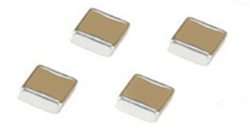The lifespan of chip capacitors has always been a question that many people are confused about. Many people don’t know how long the lifespan of chip capacitors is and how long they have been used. So today the chip capacitor manufacturer will introduce to you how to infer the lifespan of the capacitor first through the voltage The acceleration and temperature acceleration coefficients can be used to calculate the service life of the capacitor. The steps are as follows:

It can be formulated using the external ambient temperature and applied voltage when the product is in use as parameters. Generally speaking, Arrhenius' law is widely used in acceleration formulas, and we can simply calculate it using the following formula.
47_01cn.PNG Based on this formula, by conducting accelerated tests under more severe conditions (higher temperature, higher voltage), the service life of the product in the actual use environment can be calculated. Here, let’s compare the accelerated testing of monolithic ceramic capacitors with the assumed environment in which actual products are used. In the accelerated test of the capacitor, the endurance test time is regarded as LA, and the number of years in the actual use environment is regarded as LN, and used in the above formula.
Endurance test conditions assume the use of ambient voltage acceleration coefficient temperature acceleration coefficient corresponding years TA = 85°C VA = 20V LA = 1000h TN = 65°C VN = 5V n = 4 θ = 8 LN =? h In this way, we can perform a 1000h endurance test at 85°C and 20V applied voltage, and calculate that the product service life at 5°C and 5V applied voltage is 1448155h (≒165 years!). The voltage acceleration coefficient and temperature acceleration coefficient used in the calculation will vary depending on the type and structure of the ceramic material. However, the accelerated calculation formula can use the test results in a relatively short period of time to verify the use of the product in a long-term actual use environment. life.
The identification and application of capacitive components are as follows:
First: Detection of Capacitors
The main faults of capacitors are: breakdown, short circuit, leakage, capacity reduction, deterioration and damage, etc.
1. Appearance inspection
Observe that the appearance should be intact, with no cracks, dirt or corrosion on the surface, the markings should be clear, and the lead electrodes should not be broken; the adjustable capacitor should rotate flexibly, there should be no collision or friction between the moving and fixed pieces, and the rotation between the couplings should be synchronized, etc.
2. Test leakage resistance
Use the ohm setting of the multimeter (R×100 or R×1k setting) to touch the test leads to the two leads of the capacitor. When it is first connected, the meter pointer will swing, and then gradually return to R=∞. This is the charging and discharging phenomenon of the capacitor (this phenomenon cannot be observed for capacitors below 0.1μF). The greater the pointer swings, the greater the capacity. The value indicated after the pointer stabilizes is the leakage resistance value. Its value is generally several hundred to several thousand megaohms. The larger the resistance, the better the insulation performance of the capacitor will be. During the test, if the pointer on the meter points to or is close to the ohm zero point, it means that the capacitor is internally short-circuited. If the pointer does not move and always points to R=∞, it means that the capacitor is internally open-circuited or failed.
Capacitors above 5000pF can be judged by using the resistance range of a multimeter. Small-capacity capacitors below 5000pF should be judged by a special measuring instrument.
3. Polarity detection of electrolytic capacitors
The positive and negative polarities of electrolytic capacitors are not allowed to be connected incorrectly. When the polarity mark cannot be identified, it can be detected and judged based on the characteristics of large leakage resistance when connected in the forward direction and small leakage resistance when connected in the reverse direction. Measure the leakage resistance twice before and after exchanging the test leads. When the resistance value is larger, the black test lead is in contact with the positive electrode. (Because the black test lead is connected to the positive terminal of the battery inside the watch)
4. Detection of bumps or leakage of variable capacitors
Set the multimeter to the R At a certain angle, if the meter pointer points to 0Ω, it means there is contact with the chip. If the meter pointer has a certain indication or slightly swings, it means there is leakage.
Second: How to select capacitors
1. Choose the right model
According to the circuit requirements, it is generally used for low-frequency coupling, bypass decoupling, etc. When the electrical performance requirements are low, paper capacitors, electrolytic capacitors, etc. can be used.
The coupling capacitor of the transistor low-frequency amplifier should be an electrolytic capacitor of 1 to 22 μF. The bypass capacitor is selected according to the operating frequency of the circuit. For example, in a low-frequency circuit, the emitter bypass capacitor is an electrolytic capacitor with a capacity between 10 and 220 μF. In an intermediate-frequency circuit, paper and metal capacitors of 0.01 to 0.1 μF can be used. Chemical paper dielectric, organic film capacitors, etc.; in high-frequency circuits, high-frequency porcelain dielectric capacitors should be selected; if required to work at high temperatures, glass glaze capacitors, etc. should be selected. In power supply filtering and decoupling circuits, electrolytic capacitors can be used. Because in these use cases, the performance requirements of the capacitor are not high, as long as the size is not large and the capacity is sufficient.
For variable capacitors, single-connected or multiple-connected variable capacitors should be determined according to the number of capacitance unified adjustment levels, and then the corresponding types of capacitors should be determined based on the capacity change range, capacity change curve, volume and other requirements.
2. Reasonably determine the capacity and error of the capacitor
The value of the capacitor capacity must be selected according to the specified nominal value.
There are many error levels of capacitors. In low-frequency coupling, decoupling, power supply filtering and other circuits, capacitors can have error levels of ±5%, ±10%, ±20%, etc., but in oscillation loops, delay circuits, tone control circuits, etc. , the precision of the capacitor is slightly higher; in various filters and various networks, high-precision capacitors are required.
Third: Selection of voltage resistance value
In order to ensure the normal operation of the capacitor, the withstand value of the selected capacitor must not only be greater than the actual working voltage, but also leave enough room. Generally, a capacitor with a withstand voltage value that is more than twice the actual working voltage is selected.
Fourth: Pay attention to the temperature coefficient, high frequency characteristics and other parameters of the capacitor
Capacitors with small temperature coefficients should be selected for oscillation components, phase-shifting network components, filters, etc. in the oscillation circuit to ensure their performance.
Introduction to chip capacitors:
Chip capacitors are sintered at high temperatures in one go and are made of ceramic dielectric diaphragms with printed electrodes (internal electrodes) stacked in a dislocated manner.
Introduction to the internal structure of chip capacitors:
The chip capacitor mainly consists of three parts: ceramic dielectric, internal electrode, and terminal electrode. The main function of the ceramic dielectric is to polarize dielectric energy storage under the action of electric field. When the electric field changes, the polarizability changes accordingly. Since different types of media have different main polarization types, their response speeds and polarizability to changes in the electric field are also different.




